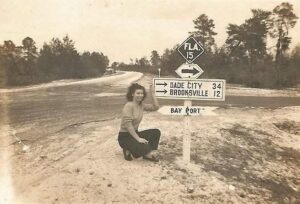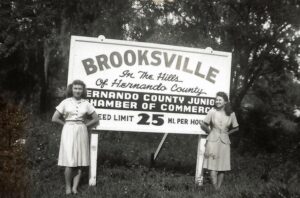In the early 1940s, the intersection of State Road 50 and Highway 19 in Weeki Wachee, Florida, was a humble crossroads in a quiet corner of Hernando County. What is now a bustling area was then a snapshot of Old Florida, characterized by open stretches of land, dense forests of pine and oak, and a slow-paced lifestyle that echoed the simplicity of the times.
The Early Days of Weeki Wachee
Before Weeki Wachee gained fame for its enchanting mermaids and crystal-clear springs, it was a sleepy community nestled along the Nature Coast. State Road 50 and Highway 19 intersected amidst a backdrop of untouched natural beauty. This junction was more than just a meeting point for travelers; it represented a connection to opportunity and growth for the local community.
State Road 50 was a vital east-west route, cutting across Florida and linking the Gulf Coast to the Atlantic. Highway 19, stretching north to south, brought travelers through Hernando County on their way to larger cities like Tampa or Tallahassee. Together, these roads formed a crucial network that facilitated trade, travel, and communication in a region still largely rural.
Life Around the Intersection
In the 1940s, the intersection was surrounded by undeveloped land dotted with small farms and homesteads. Local residents relied on these roads to transport goods, access services, and connect with neighboring towns. Horse-drawn carts and early automobiles shared the dusty roads, and the occasional gas station or general store served as a gathering place for locals and travelers alike.
The area’s economy was rooted in agriculture, with crops like citrus and cattle grazing dominating the landscape. Weeki Wachee Springs, though not yet the tourist attraction it would become, was already recognized by locals as a hidden gem—a pristine natural spring offering cool, clear waters and a serene retreat.
The Road to Growth
The intersection’s strategic location foreshadowed its eventual importance in Hernando County’s development. As Florida’s population began to grow in the mid-20th century, so did the demand for improved infrastructure. Paved roads replaced dirt paths, and the arrival of businesses and services gradually transformed the area into a hub of activity.
By the late 1940s, Weeki Wachee Springs would open as a roadside attraction, drawing visitors from across the country to witness the famous mermaid shows. This newfound attention brought increased traffic to the intersection, solidifying its role as a gateway to the wonders of Florida’s Nature Coast.
Preserving History Amid Progress
Today, the intersection of State Road 50 and Highway 19 is a far cry from its humble beginnings. Modern amenities, shopping centers, and highways have replaced the rustic charm of the 1940s, but the area’s history remains an integral part of its identity. Weeki Wachee continues to enchant visitors with its natural springs and mermaid shows, serving as a reminder of the magic that first drew people to this corner of Florida.
As we celebrate Hernando Chamber’s Centennial, it’s important to reflect on moments like these—when places we now see as busy and developed were once quiet, unassuming corners of history. The intersection of State Road 50 and Highway 19 is not just a point on a map; it’s a testament to the resilience and growth of Hernando County and its people.
Conclusion
The story of this intersection is a story of transformation, from a rural crossroads to a vibrant gateway. It captures the spirit of Hernando County’s evolution and reminds us of the enduring connection between past and present. As we look forward to the future, we honor the simple yet significant role that places like State Road 50 and Highway 19 have played in shaping our community.




